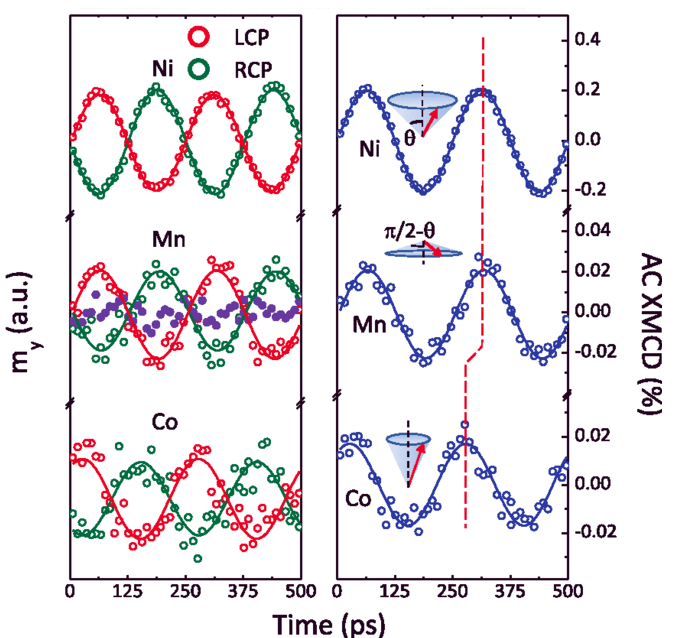Scientists working at the ALS have made the first unambiguous, direct measurements of ac spin currents flowing through nanostructured metal layers. The pioneering pump-probe technique combines timed ALS pulses with x-ray magnetic circular dichroism (XMCD) to measure the precession of spins in a nanostructure over time, directly revealing the flow of a spin current. The work represents a crucial step toward achieving a deeper understanding of spintronic phenomena, which will be required for the development of future spintronic devices that are smaller, faster, and more energy efficient.

Spin current is a key concept in spintronics research, going beyond the simple idea of a moving column of electrons with aligned spins. A spin current in fact does not require the movement of electrons, only the transport of spin angular momentum, which can take the form of a precession, or wobble, in an electron’s spin axis. Spin transport can thus occur when a wobbling electron induces a neighboring electron to wobble via a spin-transfer torque, and so on down the line. A “pure” spin current is one in which only spin angular momentum is transported—the electrons themselves remain in place, circumventing the problems associated with moving charges, such as heat generation and power losses.
To study pure spin currents, the researchers prepared a nanostructured sample consisting of two ferromagnetic layers—permalloy (Ni81Fe19) and Co—separated by a nonferromagnetic spacer layer further divided into a trilayer of Cu, Cu75Mn25, and Cu. A spin current was generated in the permalloy layer via “spin pumping,” a process in which precession of the permalloy magnetization vector is initiated by an off-axis magnetic field and maintained by a microwave rf field. That precession then induces a spin current in the neighboring spacer layer with both a time-averaged dc component (the focus of most previous work) and a time-varying ac component.
Despite the importance of spin currents and the rapid development of methods for generating them, techniques for detecting them have remained mostly indirect, resulting in ambiguous or even contradictory interpretations. In this work, the researchers focused on direct detection of the ac component of a pure spin current generated in a multilayer sample as described above. The permalloy served as the spin-pumping layer, the Cu75Mn25 layer served as the spin current “detector,” the two Cu layers were used to verify that there were no magnetic proximity effects at the interfaces (which can lead to ambiguous results), and the Co layer was used to study how the spin current transfers angular momentum to a ferromagnetic layer.
At ALS Beamline 4.0.2, the element-specific, differential absorption of left- and right-circularly polarized x-rays (XMCD) provides a way to selectively probe the precession of spins in the permalloy, Cu75Mn25, and Co layers by tuning the x-rays to the Ni, Mn, and Co L3 edges, respectively. To set up the pump-probe dynamic, the microwave pump frequency (4 GHz) was set at eight times the ALS pulse repetition rate (500 MHz), allowing eight cycles of spin precession between x-ray probe pulses. Changing the delay between the microwave pump and the x-ray probe enabled coverage of the full spin precession, as shown by the sinusoidal shape of the recorded XMCD signals.

After careful elimination of other possible mechanisms for the Mn XMCD data, the researchers concluded that the observation of precession in the Cu75Mn25 layer is direct, unambiguous evidence of the existence of a pure spin current there. Furthermore, phase-resolved precession measurements revealed a characteristic bipolar phase behavior in the Co spins, validating the conclusion that the precession in that layer was driven by the spin current. The success of this method for probing spin currents opens the door to studying spin current propagation in different materials, and the researchers plan to extend their studies to spin currents in antiferromagnetic materials.

Contact: Z.Q. Qiu
Research conducted by: J. Li (Peking Univ. and UC Berkeley); L.R. Shelford, P.S. Keatley, and R.J. Hicken (Univ. of Exeter, UK); P. Shafer and E. Arenholz (ALS); A. Tan, J.X. Deng, and Z.Q. Qiu (UC Berkeley); C. Hwang (Korea Research Institute of Standards and Science); and G. van der Laan (Diamond Light Source).
Research funding: National Science Foundation and National Research Foundation of Korea. Operation of the ALS is supported by the U.S. Department of Energy, Office of Basic Energy Sciences.
Publication about this research: J. Li, L.R. Shelford, P. Shafer, A. Tan, J.X. Deng, P.S. Keatley, C. Hwang, E. Arenholz, G. van der Laan, R.J. Hicken, and Z.Q. Qiu, “Direct detection of pure ac spin current by x-ray pump-probe measurements,” Phys. Rev. Lett. 117, 076602 (2016). doi.org/10.1103/PhysRevLett.117.076602
ALS SCIENCE HIGHLIGHT #341